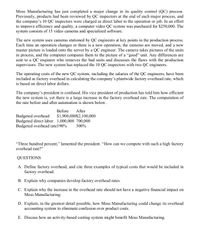
FINANCIAL ACCOUNTING
10th Edition
ISBN: 9781259964947
Author: Libby
Publisher: MCG
expand_more
expand_more
format_list_bulleted
Concept explainers
Question
ANSWER ALL PLEASE

Transcribed Image Text:Moss Manufacturing has just completed a major change in its quality control (QC) process.
Previously, products had been reviewed by QC inspectors at the end of each major process, and
the company's 10 QC inspectors were charged as direct labor to the operation or job. In an effort
to improve efficiency and quality, a computer video QC system was purchased for $250,000. The
system consists of 15 video cameras and specialized software.
The new system uses cameras stationed by QC engineers at key points in the production process.
Each time an operation changes or there is a new operation, the cameras are moved, and a new
master picture is loaded onto the server by a QC engineer. The camera takes pictures of the units
in process, and the computer compares them to the picture of a "good" unit. Any differences are
sent to a QC engineer who removes the bad units and discusses the flaws with the production
supervisors. The new system has replaced the 10 QC inspectors with two QC engineers.
The operating costs of the new QC system, including the salaries of the QC engineers, have been
included as factory overhead in calculating the company's plantwide factory overhead rate, which
is based on direct labor dollars.
The company's president is confused. His vice president of production has told him how efficient
the new system is, yet there is a large increase in the factory overhead rate. The computation of
the rate before and after automation is shown below.
Before
After
Budgeted overhead
Budgeted direct labor 1,000,000 700,000
Budgeted overhead rate190%
$1,900,000$2,100,000
300%
"Three hundred percent," lamented the president. “How can we compete with such a high factory
overhead rate?"
QUESTIONS
A. Define factory overhead, and cite three examples of typical costs that would be included in
factory overhead.
B. Explain why companies develop factory overhead rates.
C. Explain why the increase in the overhead rate should not have a negative financial impact on
Moss Manufacturing.
D. Explain, in the greatest detail possible, how Moss Manufacturing could change its overhead
accounting system to eliminate confusion over product costs.
E. Discuss how an activity-based costing system might benefit Moss Manufacturing.
Expert Solution
This question has been solved!
Explore an expertly crafted, step-by-step solution for a thorough understanding of key concepts.
This is a popular solution
Trending nowThis is a popular solution!
Step by stepSolved in 2 steps

Knowledge Booster
Learn more about
Need a deep-dive on the concept behind this application? Look no further. Learn more about this topic, accounting and related others by exploring similar questions and additional content below.Similar questions
arrow_back_ios
arrow_forward_ios
Recommended textbooks for you

 AccountingAccountingISBN:9781337272094Author:WARREN, Carl S., Reeve, James M., Duchac, Jonathan E.Publisher:Cengage Learning,
AccountingAccountingISBN:9781337272094Author:WARREN, Carl S., Reeve, James M., Duchac, Jonathan E.Publisher:Cengage Learning, Accounting Information SystemsAccountingISBN:9781337619202Author:Hall, James A.Publisher:Cengage Learning,
Accounting Information SystemsAccountingISBN:9781337619202Author:Hall, James A.Publisher:Cengage Learning, Horngren's Cost Accounting: A Managerial Emphasis...AccountingISBN:9780134475585Author:Srikant M. Datar, Madhav V. RajanPublisher:PEARSON
Horngren's Cost Accounting: A Managerial Emphasis...AccountingISBN:9780134475585Author:Srikant M. Datar, Madhav V. RajanPublisher:PEARSON Intermediate AccountingAccountingISBN:9781259722660Author:J. David Spiceland, Mark W. Nelson, Wayne M ThomasPublisher:McGraw-Hill Education
Intermediate AccountingAccountingISBN:9781259722660Author:J. David Spiceland, Mark W. Nelson, Wayne M ThomasPublisher:McGraw-Hill Education Financial and Managerial AccountingAccountingISBN:9781259726705Author:John J Wild, Ken W. Shaw, Barbara Chiappetta Fundamental Accounting PrinciplesPublisher:McGraw-Hill Education
Financial and Managerial AccountingAccountingISBN:9781259726705Author:John J Wild, Ken W. Shaw, Barbara Chiappetta Fundamental Accounting PrinciplesPublisher:McGraw-Hill Education


Accounting
Accounting
ISBN:9781337272094
Author:WARREN, Carl S., Reeve, James M., Duchac, Jonathan E.
Publisher:Cengage Learning,

Accounting Information Systems
Accounting
ISBN:9781337619202
Author:Hall, James A.
Publisher:Cengage Learning,

Horngren's Cost Accounting: A Managerial Emphasis...
Accounting
ISBN:9780134475585
Author:Srikant M. Datar, Madhav V. Rajan
Publisher:PEARSON

Intermediate Accounting
Accounting
ISBN:9781259722660
Author:J. David Spiceland, Mark W. Nelson, Wayne M Thomas
Publisher:McGraw-Hill Education

Financial and Managerial Accounting
Accounting
ISBN:9781259726705
Author:John J Wild, Ken W. Shaw, Barbara Chiappetta Fundamental Accounting Principles
Publisher:McGraw-Hill Education